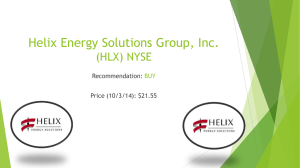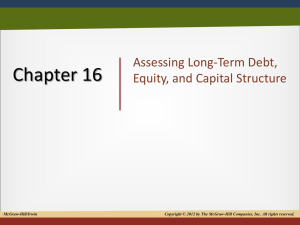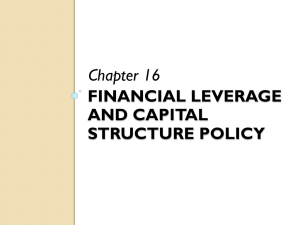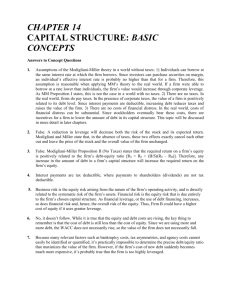Capital Structure
advertisement
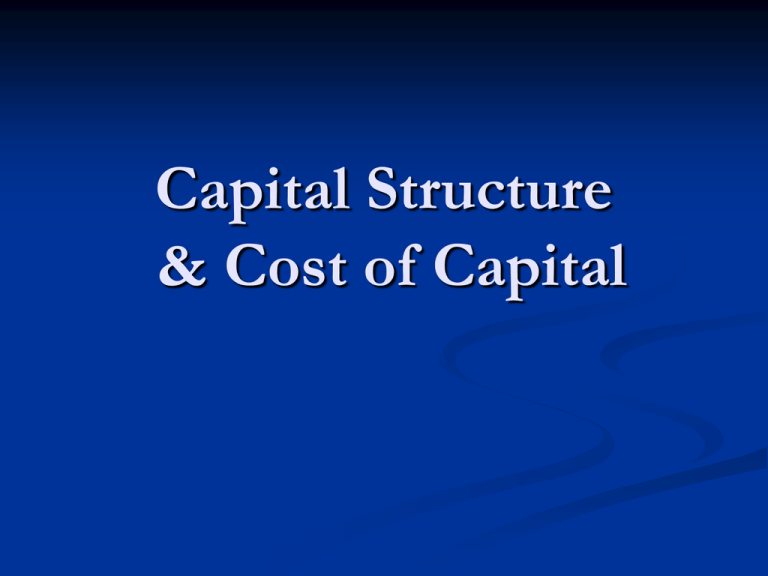
Capital Structure & Cost of Capital Introduction Capital budgeting affects the firm’s well-being Discount rate is based on the risk of the cash flows Errors in capital budgeting can be serious Need to compensate investors for financing Project Expect Return Project Cash Flows WACC Weighted Average Cost of Capital Also called the hurdle rate D = Market Value of Debt E = Market Value of Equity P = Market Value of Preferred Stock V=D+E+P Costs of Financing Cost of Preferred Stock Cost of Debt Based on preset dividend rate (r = D/P) YTM is good estimate Cost of Common Stock Derived from current market data – Beta Cost has 2 factors Business or Asset Risk Financing or Leverage Risk (Leverage increases common stock risk) Cost of Equity Example Market risk premium = 9% Current risk-free rate = 6% Company beta = 1.5 Last dividend = $2, dividend growth = 6%/year Stock price = $15.65 What is our cost of equity? Example – WACC Equity Information Cost of equity? 50 million shares $80 per share Beta = 1.15 Market risk prem. = 9% Risk-free rate = 5% RE = Cost of debt? RD = Debt Information $1 billion Coupon rate = 10% YTM = 8% 20 years to maturity Tax rate = 40% Example – WACC Capital structure weights? E = 50 million shares ($80/share) = $4 billion D = $1 billion face V = 4 + 1 = $5 billion wE = E/V = wD = D/V = What is the WACC? WACC = Capital Restructuring Capital restructuring Adjusting leverage without changing the firm’s assets Increase leverage Decrease leverage Issue debt and repurchase outstanding shares Issue new shares and retire outstanding debt Choose capital structure to max stockholder wealth Maximizing firm value Minimizing the WACC Ex: Effect of Leverage Current Assets Proposed $5,000,000 $5,000,000 $0 $2,500,000 $5,000,000 $2,500,000 0 1 $10 $10 # Shares 500,000 250,000 Int. Rate N/A 10% Debt Equity D/E Share $ EBIT $650,000 D = $0 Interest = 0, Net Income = $650,000 EPS = $650,000/500,000 = $1.30 D = $2.5 mil Interest = Net Income = EPS = (D/E = 1) /250,000 = EBIT $300,000 D = $0 Interest = 0, Net Income = $300,000 EPS = $300,000/500,000 = $0.60 D = $2.5 mil (D/E = 1) Interest = $2,500,000 * 10% = $250,000 Net Income = EPS = /250,000 = Break-Even EBIT EBIT where EPS is the same under both the current and proposed capital structures If EBIT > break-even point then leverage is beneficial to our stockholders If EBIT < break-even point then leverage is detrimental to our stockholders Ex: Break-Even EBIT EPSAll Equity EPSWith Debt EBIT EBIT 250,000 500,000 250,000 500,000 EBIT 250,000 EBIT 250,000 EBIT 2 * EBIT 500,000 EBIT $500,000 Cost of Equity Varies If the level of debt increases, the riskiness of the firm increases. Increases the cost of debt. However, the riskiness of the firm’s equity also increases, resulting in a higher re. Impact of Leverage $200,000 in assets, all equity, 10,000 shares Pre-tax Taxes Net Demand Prob EBIT Interest Income 40% Income ROE EPS Terrible 0.05 ($60,000) $0 ($60,000) ($24,000) ($36,000) -18.00% ($3.60) Poor 0.2 ($20,000) $0 ($20,000) ($8,000) ($12,000) -6.00% ($1.20) Normal 0.5 $40,000 $0 $40,000 $16,000 $24,000 12.00% $2.40 Good 0.2 $100,000 $0 $100,000 $40,000 $60,000 30.00% $6.00 Great 0.05 $140,000 $0 $140,000 $56,000 $84,000 42.00% $8.40 $40,000 $0 $40,000 $16,000 $24,000 12.00% $2.40 14.82% $2.96 E(value): Std Dev: Impact of Leverage $200,000 in assets, half equity, 5,000 shares Pre-tax Taxes Net Demand Prob EBIT Interest Income 40% Income ROE EPS Terrible 0.05 ($60,000) $12,000 ($72,000) ($28,800) ($43,200) -43.20% ($8.64) Poor 0.2 ($20,000) $12,000 ($32,000) ($12,800) ($19,200) -19.20% ($3.84) Normal 0.5 $40,000 $12,000 $28,000 $11,200 $16,800 16.80% $3.36 Good 0.2 $100,000 $12,000 $88,000 $35,200 $52,800 52.80% $10.56 Great 0.05 $140,000 $12,000 $128,000 $51,200 $76,800 76.80% $15.36 $40,000 $12,000 $28,000 $11,200 $16,800 16.80% $3.36 29.64% $5.93 E(value): Std Dev: M&M – Perfect Market Miller and Modigliani (1958) Fathers of capital structure theory Proposition I Firm value is NOT affected by the capital structure Since cash flows don’t change, value doesn’t change Proposition II Firm WACC is NOT affected by capital structure M&M – Perfect Market Assumes no taxes or bankruptcy costs WACC = (E/V)RE + (D/V)RD No taxes RE = RA + (RA – RD)(D/E) RA: “cost” of the firm’s business risk (RA – RD)(D/E): “cost” of the firm’s financial risk Risks Business risk: Uncertainty in future EBIT Depends on business factors such as competition, industry trends, etc. Level of systematic risk in cash flows Financial risk: Extra risk to stockholders resulting from leverage Depends on the amount of leverage NOT the same as default risk M&M – Perfect Market Ex: Perfect Market RA = 16%, RD = 10%; % debt = 45% Cost of equity? RE = 16 + (16 - 10)(.45/.55) = 20.91% If the cost of equity is 25%, what is D/E? 25 = 16 + (16 - 10)(D/E) D/E = Then, what is the % equity in the firm? E/V = Capital Structure Example Balance Sheet Assets (A) 100 Assets 100 Debt Value (D) Equity Value (E) Firm Value (V) rdebt=8% & requity=15% WACC = rassets =(D/V)* rdebt + (E/V)* requity WACC = 40 60 100 Capital Structure Example New capital structure Assets (A) 100 Assets 100 Debt Value (D) Equity Value (E) Firm Value (V) Has the risk of the project changed? Is the go-ahead decision different? 30 70 100 After Refinancing Before WACC = .4 (8%) + .6 (15%) = 12.2% After Imagine cost of debt dropped to 7.3% WACC = .3 (7.3%) + .7 (requity) = 12.2% requity = Example Debt/equity mix doesn’t affect the project’s inherent risk However reducing debt level changes the required returns Required return on the package of debt and equity is unaffected Reduced debtholder risk (rdebt fell) Reduced equityholder risk (requity fell) How is it, then, that reducing firm risk did not reduce the required rate of return? Project risk is the same. Weights changed. Corporate Taxes Interest is tax deductible Effectively, govt subsidizes part of interest payment Adding debt can reduce firm taxes Reduced taxes increases the firm cash flows Ex: Taxes Unlevered Levered EBIT Interest ($6250 @ 8%) 5000 0 5000 500 Taxable Income 5000 4500 Taxes (34%) 1700 1530 Net Income 3300 2970 Bondholders Equityholders Total Cash Flows 0 3300 3300 500 2970 3470 Interest Tax Shield Annual interest tax shield Tax rate times interest payment $6250 * .08 = $500 in interest expense Annual tax shield = .34(500) = 170 PV of annual interest tax shield Assume perpetual debt PV = PV = D(RD)(TC) / RD = DTC = Taxes – Firm Value Firm value increases by value of tax shield VL = VU + PV (interest tax shield) If perpetuity, VU = EBIT(1-.t) / rA Value of equity = Value of the firm – Value of debt Ex: Unlevered cost of capital (rA)= 12%; t = 35%; EBIT = 25 mil; D = $75 mil; rD = 9%; VU = VL = E= Taxes - WACC WACC decreases as D/E increases WACC = (E/V)RE + (D/V)(RD)(1-TC) RE = RA + (RA – RD)(D/E)(1-TC) rA = 12%; t = 35%; D = $75 mil; rD = 9%; VU = $135.42 mil; VL = $161.67 mil; E = $86.67 mil RE = WACC= Example: Proposition II - Taxes Firm restructures its capital so D/E = 1 rA= 12%; t = 35%; rD = 9% New cost of equity? RE = New WACC? WACC = Taxes + Bankruptcy Probability of bankruptcy increases with debt Increases the expected bankruptcy costs Eventually, the additional value of the interest tax shield will be offset by the increase in expected bankruptcy cost At this point, the value of the firm will start to decrease and the WACC will start to increase Cost of Debt Varies Amount borrowed $ 0 D/V ratio 0 D/E ratio 0 Bond rating -- rd -- 250 0.125 0.1429 AA 8.0% 500 0.250 0.3333 A 9.0% 750 0.375 0.6000 BBB 11.5% 1,000 0.500 1.0000 BB 14.0% Times Interest Earned TIE = EBIT / Interest EBIT = $400,000 t=40% 80,000 shares outstanding, with price of $25 D $0 ( EBIT - k d D )( 1 - T ) EP S Shares outstanding ($400,000) (0.6) 80,000 $3.00 EPS & TIE: D = $250,000, rd = 8% $250,000 Shares repurchased 10,000 $25 ( EBIT - k d D )( 1 - T ) EP S Shares outstanding ($400,000- 0.08($250, 000))(0.6) 80,000- 10,000 $3.26 EBIT $400,000 T IE 20x Int Exp $20,000 EPS & TIE D = $500,000, rd = 9% $500,000 Shares repurchased 20,000 $25 ( EBIT - k d D )( 1 - T ) EPS Shares outstanding ($400,000 - 0.09($500,000))(0.6) 80,000 - 20,000 $3.55 EBIT $400,000 TIE 8.9x Int Exp $45,000 Bankruptcy Costs Direct costs Legal and administrative costs Additional losses for bondholder Indirect bankruptcy or financial distress costs Preoccupies management Reduces sales Lose valuable employees Options of Distress The right to go bankrupt Valuable Protects creditors from further loss of assets Creditors will renegotiate – why? Avoid bankruptcy costs Voluntary debt restructuring Tradeoff Theory Tradeoff between the tax benefits and the costs of distress. Tradeoff determines optimal capital structure VL = VU + tC*D - PV (cost of distress) With higher profits, what should happen to debt? In Practice Tax benefit matters only if there’s a large tax liability Risk and costs of financial distress vary Capital structure does differ by industries Lowest levels of debt Increased risk of financial distress Increased cost of financial distress Pharma, Computers Highest levels of debt Steel, Department stores, Utilities WACC Review Capital budgeting affects the firm’s well-being Discount rate is based on the risk of the cash flows Errors in capital budgeting can be serious Need to compensate investors for financing Project Expect Return > Cost of Capital Project Cash Flows > Return to Investors General Electric 6 Divisions Commercial Finance – loans, leases, insurance Healthcare – medical technology, drug discovery Industrial – appliances, lighting, equipment services Infrastructure – aviation, water, oil & gas technology Money – consumer finance (credit cards, auto loans) NBC Universal – entertainment and news Project WACC Using a general industry or company cost of capital will lead to bad decisions. Using Firm WACC Only for projects that mirror the overall firm risk Only be used if the new financing has the same proportion of debt, preferred, and equity Otherwise, use the project cost of capital Pure Play Find several publicly traded companies exclusively in project’s business Use pure play betas to proxy for project’s beta May be difficult to find such companies Note if the pure play is levered Betas are non-stationary over time Cross-sectional variation of betas, even within the same industry Leverage & Beta Equity risk = business risk (operating leverage) + financial risk (financial leverage) L = U(1+(1-t)D/E) L = E = Equity beta = Levered beta U = A = Asset beta = Unlevered beta t = Company’s marginal tax rate Capital Structure & Beta Beta varies with capital choice Original Capital Structure debt = .2 equity = 1.2 (40/100)*.2 + (60/100)*1.2 = assets = .8 Debt drops to 30% assets (U) = portfolio = (D/V) debt + (E/V) equity Suppose the debt beta falls to .1 Then, assets(U) = .8 = (.3 * .1) + (.7 * equity) so equity = 1.1 Unlever betas, we move from an observed equity to asset Leverage & Beta Firm with no debt decides to issue $100 million in bonds and retire some outstanding stock. Historically, βL = .75 Value of the equity after $100 million is retired is $235 million. The tax rate is 35%. What is β after the transaction? L = U(1+(1-t)D/E), where L = lev, U= unlev L = Post-Acquisition Beta 1995: Disney announced it was acquiring Capital Cities for $120/share At acquisition, Disney equity (L) = 1.15 E = $31.1 bil D = $3.186 bil Based on $120 offer price, Capital Cities equity(L) = 0.95 E = $18.5 bil Corporate tax rate was 36% D = $615 mil Disney/Capital Cities Step 1 Step 2 Find unlevered betas for each company Use market values of DIS & CC to find unlevered beta of combined firm Step 3 Find levered beta using leverage of combined firm 1) Unlevered Betas U L 1 (1 T ) * ( D ) E 2) Combined Beta 3) Levered Beta




